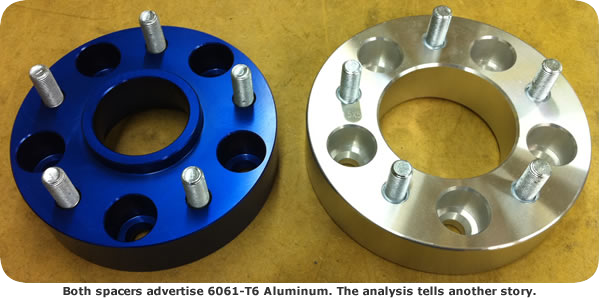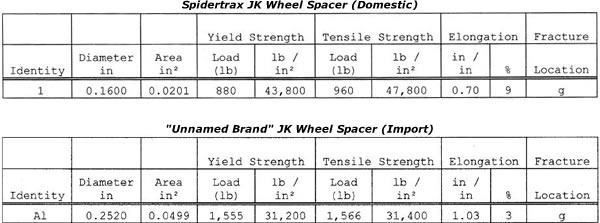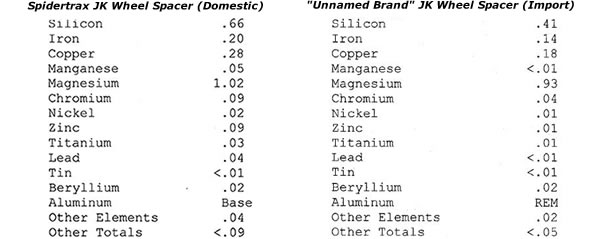Domestic vs. Import Wheel Spacers: Mechanical & Material Analysis

1. Introduction
The seemingly unending debate of outsourcing & offshoring is back on top of America’s “What Matters Most” list. As the proud co-owner of Spidertrax Off-Road, an American company that designs & manufactures its products in-house, it should come of no surprise what side of this debate I sit. My interests however in publishing this article lie not in politics but in engineering ethics, focusing not on “you get what you pay for” but rather “you didn’t get what was advertised”.
Below is a detailed mechanical & material analysis between a Spidertrax JK Wheel Spacer (Domestic) & an “Unnamed Brand”* JK Wheel Spacer (Import). The take away here is not so much one product being superior to another. The issue is with the import wheel spacer being advertised as using 6061-T6, the same high quality material used in our domestic wheel spacer. Although these claims leave the impression that both products are virtually identical, the analysis detailed below tells another story.
*Before moving onto the results, I wanted to clear up any confusion ahead of time regarding the use of “Unnamed Brand”. The conflict in sharing this identity comes from singling out just one manufacture as we have duplicated these same test results from other import wheel spacer manufacturers. So, in an effort in “taking the high road” the import manufacture in this test will remain nameless and be referred to only as “Unnamed Brand”.
2a. Tensile Test (Aluminum Spacer)
Both domestic and import JK wheel spacers are advertised as using “6061-T6” aluminum. As referenced on MatWeb, Aluminum 6061-T6 should provide a minimum Tensile Strength (Yield) of 40,000 psi & a minimum Tensile Strength (Ultimate) of 45,000 psi.

As shown above, our domestic wheel spacer exceeds the minimum requirements for 6061-T6 (as advertised). The import wheel spacer, on the other hand, is off nearly 35% in terms of Tensile Strength for 6061-T6 (not as advertised). What is just as, if not more, concerning is the closeness in value between Yield Strength and Tensile Strength for the import spacer. This closeness in value suggests the material is cast and not billet (also not as advertised).
2b. Chemical Analysis (Aluminum Spacer)
This test confirms that, although there are differences in material composition as shown below, both our domestic wheel spacer & import wheel spacer conform to a 6061 series grade.

There is an important distinction made when combining the results of both the tensile test & chemical analysis though. When combined, the results clearly show our domestic wheel spacer is indeed billet 6061-T6 (as advertised) while the import wheel spacer is cast 6061 (not as advertised).
2c. Hardness (Wheel Stud)
The last test is a cross sectional hardness traverse on the wheel stud (a component which is pressed into the wheel spacer).

The results, as per SAE J429, indicate our domestic wheel stud exceeds Grade 8 specification (as advertised) while the import wheel stud meets Grade 5 specification (not as advertised).
3. Conclusion
As shown in the above analysis our domestic wheel spacers are manufactured from billet 6061-T6 aluminum and run Grade 8 wheel studs as advertised. Although the import wheel spacer is advertised using these same high quality materials, the above analysis proves it is manufactured out of nothing more then cast 6061 running Grade 5 wheel studs. “Buyer Beware” certainly doesn’t capture these outrageous findings.
For reference, you can also download a copy of the complete Domestic & Import metallurgical reports. All testing as detailed in this article was performed by Colorado Metallurgical Services (CMS). Spidertrax Inc. (Spidertrax Off-Road) is not affiliated with or a subsidiary of CMS.
